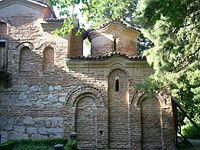Boyana Church



The Boyana Church (Bulgarian: Боянска църква, Boyanska tsarkva) is a medieval Bulgarian Orthodox church situated on the outskirts of Sofia, the capital of Bulgaria, in the Boyana quarter. The east wing of the two-storey church was originally constructed in the late 10th or early 11th century, then the central wing was added in the 13th century under the Second Bulgarian Empire, the whole building being finished with a further expansion to the west in the middle of the 19th century.
The church owes its world fame mainly to its frescoes from 1259. They form a second layer over the paintings from earlier centuries and represent one of the most complete and well-preserved monuments of Eastern European mediaeval art. A total of 89 scenes with 240 human images are depicted on the walls of the church. The painter is anonymous, but is possibly from the Tarnovo Art School.
18 scenes in the narthex depict the life of Saint Nicholas. The painter here drew certain aspects of contemporary lifestyle. In The Miracle at Sea, the ship and the sailors' hats recall the Venetian fleet. The portraits of the patrons of the church — Sebastocrator Kaloyan and his wife Desislava, as well as those of Bulgarian tsar Constantine Tikh and Tsaritsa Irina, are thought to be among the most impressive and lifelike frescoes in the church, and are located on the north wall of the church.
Besides the first layer of 11th-12th century frescoes, of which only fragments are preserved, and the famous second layer of murals from 1259, the church also has a smaller number of later frescoes from the 14th and 16th-17th century, as well as from 1882.
The monument was added to the UNESCO World Heritage List in 1979. The frescoes were restored and cleaned in 1912-1915 by an Austrian and a Bulgarian specialist, as well in 1934 and 1944. The church was closed for the public in 1977 in order to be conservated and restored and once again opened in 2000.
The church patrons' inscription in Middle Bulgarian from 1259 reads:[1]
+взъдвиже сѧ ѽ земѧ и създа сѧ прѣчисты хра
мъ ст҃аго иерарха х҃ва николы ст҃аго и великѡ
славнагѡ мѫченика хв҃а пантелеимѡна тече
ниемъ и трѹдомъ и любовиаѧ многоаѫ калѡ
ѣнѣ севастократора братѹчѧди цр҃ва внѹкъ ст҃а
стефана кралѣ србьскаго написа же сѧ при цр҃
вство блгарское при благовѣрнем и бг҃очь
стивѣмъ и хр҃столюбивѣмъ цр҃и костан
динѣ асѣна едикто з҃ в лѣто
.ѕ҃.ѱ.ѯ҃з҃
This immaculate temple of the Holy Christ's hierarch Nicholas and of the Christ's holy and most glorious martyr Panteleimon was erected from the ground and created with the funds, care and great love of Kaloyan, sebastocrator, cousin of the Tsar, grandson of Saint Stephen, King of Serbia. This was written in the Bulgarian Empire under the pious and devout Tsar Constantine Asen. Indict 7 of the year 6767 [1259].

